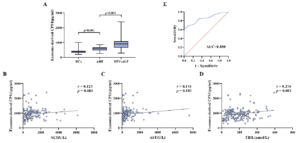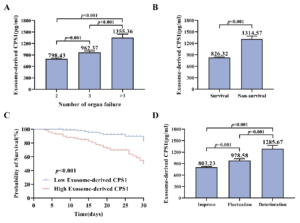Although hepatitis E virus (HEV) infection is usually asymptomatic and results in a self-limited disease with low mortality, some patients, particularly pregnant women, the elderly, and people with previous underlying liver diseases, exhibit typical symptoms of acute viral hepatitis (AVH) and develop acute liver failure (ALF), which even results in death. The risk of developing HEV-ALF is considered to be 50% among pregnant women infected with HEV. Furthermore, surprisingly, the mortality of HEV infection is as high as 75% in patients with underlying liver diseases. Early diagnosis, early treatment, and active prevention of complications are emphasized in the treatment of HEV-ALF. Therefore, efficient predictive evaluation, dynamic monitoring of patient’s conditions, and accurate prognostic evaluation are of great significance for the prevention and treatment of HEV-ALF.
A recent study designed by Prof. Jian Wu from Affiliated Suzhou Hospital of Nanjing Medical University, Dr. Ze Xiang from Zhejiang University, China, collected serum samples and evaluate serum exosome-derived carbamoyl phosphate synthase 1 (CPS1) levels in 200 health controls (HCs), 200 patients with acute hepatitis E (AHE) and 200 HEV-ALF patients. The diagnostic and prognostic value of exosome-derived CPS1 levels were determined.
The exosome-derived CPS1 levels in the HEV-ALF group were significantly higher than those in the AHE and HCs groups. The area under the curve (AUC) of exosome-derived CPS1 to predict the occurrence of HEV-ALF was 0.850 (0.811-0.883). There also existed the positive linear relation between exosome-derived CPS1 levels and TBIL (Figure 1). Both logistical regression and orthogonal partial least squares discriminant analysis (OPLS-DA) showed that exosome-derived CPS1 is independent risk factor for HEV-ALF. It was revealed that the levels of serum exosome-derived CPS1 were significantly correlated with the occurrence of ALF in AHE patients. The exosome-derived CPS1 levels were positively correlated with organ failure. The levels of serum exosome-derived CPS1 in the survival group were significantly lower than those in the non-survival group. The survival time of the group with low exosome-derived CPS1 levels was significantly longer than that of the group with high exosome-derived CPS1 levels.

Figure 1 The relationship between the serum exosome-derived CPS1 levels and occurrence of HEV-ALF. (A) The levels of exosome-derived CPS1 in the HCs group (n = 200), AHE group (n = 200) and HEV-ALF group (n = 200); (B-D) The levels of exosome-derived CPS1 were positively correlated with the liver function parameters, including ALT (r = 0.123; P = 0.084), AST (r = 0.116; P = 0.101) and TBIL (r =0.216; P =0.002); (E) The ability of exosome-derived CPS1 to predict the occurrence of HEV-ALF.
Besides, the exosome-derived CPS1 levels in the worsening group were significantly higher than those in the fluctuating and the improving groups (Figure 2). Therefore, serum exosome-derived CPS1 levels are closely associated with the prognosis of HEV-ALF patients. The higher the serum exosome-derived CPS1 levels, the worse the prognosis of HEV-ALF patients. Moreover, the AUC of serum exosome-derived CPS1 to predict 30-day mortality was 0.829 (0.770-0.879), which was significantly greater than that of the Child-Pugh, KCH, and MELD model.

Figure 2 Correlation between serum exosome-derived CPS1 and prognosis of HEV-ALF patients. (A) The serum exosome-derived CPS1 levels in HEV-ALF patients increased accompanied by the increase in the number of failed organs; (B) The levels of exosome-derived CPS1 in the survival group were significantly higher than those in the non-survival group; (C) The survival time of patients in the low exosome-derived CPS1 level group was significantly longer than that of patients in the high exosome-derived CPS1 level group; (D)Compared to the improving group, the exosome-derived CPS1 levels in the fluctuating group at admission increased significantly. The exosome-derived CPS1 levels in the worsening group at admission increased significantly increased significantly compared with the fluctuating group.
Hence, the level of serum exosome-derived CPS1 might serve as a promising diagnostic and prognostic biomarker for HEV-ALF patients, which may provide better guidance for the diagnosis, prognosis, and treatment of HEV-ALF patients.
Read the full article: https://onlinelibrary.wiley.com/doi/epdf/10.1002/jmv.27961

